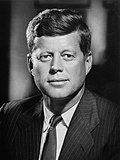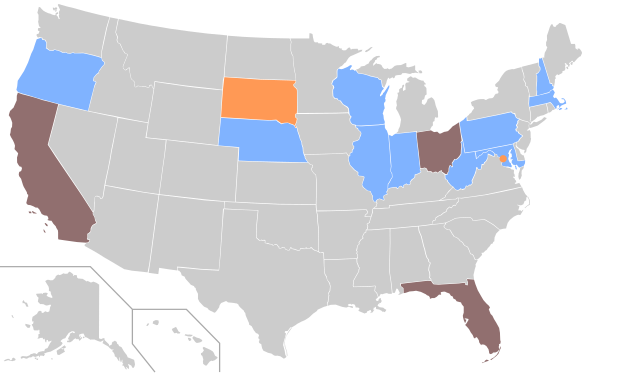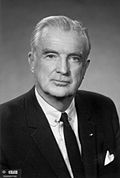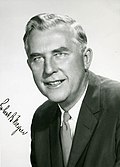Top Qs
Timeline
Chat
Perspective
1960 Democratic Party presidential primaries
Selection of the Democratic Party nominee From Wikipedia, the free encyclopedia
Remove ads
From March 8 to June 7, 1960, voters and members of the Democratic Party elected delegates to the 1960 Democratic National Convention through a series of caucuses, conventions, and primaries, partly for the purpose of nominating a candidate for President of the United States in the 1960 election. The presidential primaries were inconclusive, as several of the leading contenders did not enter them, but U.S. Senator John F. Kennedy of Massachusetts emerged as the strongest candidate and won the nomination over Lyndon B. Johnson at the convention, held from July 11 to 15 at the Los Angeles Memorial Sports Arena.
Recalling the experience of 1928 Democratic nominee Al Smith (who was Catholic), many wondered if anti-Catholic prejudice would affect Kennedy's chances of winning the nomination and the election in November.[1] To prove his vote-getting ability, Kennedy challenged U.S. senator Hubert Humphrey of Minnesota, a liberal, in the Wisconsin primary. Although Kennedy defeated Humphrey in Wisconsin, his reliance on heavily Catholic areas left many party bosses unconvinced. Kennedy thus faced Humphrey in the heavily Protestant state of West Virginia. Humphrey's campaign was low on money and could not compete with the well-organized, well-financed Kennedy team. Kennedy's siblings combed the state looking for votes, leading Humphrey to complain that he "felt like an independent merchant running against a chain store."[2] On primary day, Kennedy crushed Humphrey with over 60% of the vote, and Humphrey withdrew from the race.
Although Kennedy won the popular contests by comfortable margin, his main opponent, Senate Majority Leader Lyndon B. Johnson, did not participate (except as a write-in candidate). Johnson had a very strong base in the party establishment and gained the support of many delegates chosen through caucus and convention selection processes.[3] In the months leading up to the Democratic Convention, Kennedy traveled around the nation persuading delegates from various states to support him. However, as the Convention opened, Kennedy was still a few dozen votes short of victory.[citation needed]
Several major candidates served as Democratic Party nominees, with John F. Kennedy serving as the nominee for 1960, Johnson in 1964, and Humphrey in 1968.
Remove ads
Background
Summarize
Perspective
1952 and 1956 elections
After controlling the White House for five consecutive terms from 1933 through 1953, the Democratic Party had been defeated in two consecutive elections. Both times, popular World War II general Dwight D. Eisenhower defeated Adlai Stevenson II.[4]

At the 1956 Democratic National Convention, Stevenson surprisingly left the choice of his vice-presidential running mate to the delegates.[5] Following his nomination in Chicago, Stevenson made a brief appearance before the convention. He told the delegates he had decided "to depart from the precedents of the past" and that "the selection of the Vice Presidential nominee should be made through the free processes of this convention."[6] With one day's notice, the candidates scrambled to assemble campaigns for delegate support. The leaders were Estes Kefauver, who had run two populist campaigns for the presidency but lost the nomination each time to Stevenson, and John F. Kennedy, a relatively unknown 39-year-old United States Senator from Massachusetts but a scion of the powerful Kennedy family. Kennedy surprised observers by surging into the lead on the second ballot and falling only 39 votes short of the nomination, but on the third ballot, several favorite son candidates threw their delegations' support to Kefauver, and he prevailed. Kennedy gave a gracious concession speech, raising his national profile within the party.[7]
1958 midterm elections
In the 1958 elections, the Republican Party suffered heavy losses due to a nationwide economic recession, the launch of Sputnik by the Soviet Union, and the galvanized opposition of organized labor following the passage of strengthened labor restrictions. Kennedy was re-elected in a historic landslide; the gain of ten Senate seats also buttressed the political power of Senate Majority Leader Lyndon B. Johnson, who had won the regional support of some Southern delegations in 1956.[8]
"Democrats won seats in the Senate in California, Connecticut, Indiana, Maine, Michigan, Minnesota, Nevada, New Jersey, Ohio, Utah, West Virginia and Wyoming." Democrats conceded no seats they had obtained in previous years.[8]
Remove ads
Candidates
Summarize
Perspective
The following political leaders were candidates for the 1960 Democratic presidential nomination:
Nominee
Other major candidates
These candidates participated in multiple state primaries or were included in multiple major national polls.
Favorite sons
The following candidates ran only in their home state's primary or caucus for the purpose of controlling its delegate slate at the convention and did not appear to be considered national candidates by the media.
- Governor Ross Barnett of Mississippi
- Governor Pat Brown of California (pledged support to Kennedy)
- Governor Michael DiSalle of Ohio (pledged support to Kennedy)
- Governor Herschel Loveless of Iowa
- George H. McLain of California
- Albert S. Porter of Ohio
- Senator George Smathers of Florida
Declined to run
The following persons were listed in two or more major national polls or were the subject of media speculation surrounding their potential candidacy, but declined to actively seek the nomination.
- Senator Joseph Clark of Pennsylvania
- Former Governor Frank G. Clement of Tennessee
- Governor Orval Faubus of Arkansas
- Senator Albert Gore of Tennessee
- Former Governor W. Averell Harriman of New York
- Senator Estes Kefauver of Tennessee
- Senator Edmund Muskie of Maine
- Governor G. Mennen Williams of Michigan
Remove ads
Polling
Summarize
Perspective
National polling
This graph was using the legacy Graph extension, which is no longer supported. It needs to be converted to the new Chart extension. |
- Favorite sons received the support of Missouri (Stuart Symington), Florida (George Smathers), New Jersey (Robert Meyner), Mississippi (Ross Barnett), and Hawaii. (Adlai E. Stevenson II)
Two-way races
Kennedy v. Kefauver
Kennedy v. Johnson
Kennedy v. Stevenson
Johnson v. Symington
Statewide polling
West Virginia
Wisconsin
Remove ads
Schedule and results
Summarize
Perspective
States by winner
Remove ads
Primary race
Summarize
Perspective
From the outset of the campaign, Kennedy's religion played a major role. Happy Chandler, the governor of Kentucky and a major power broker in the party, emphatically stated that Kennedy could not win Kentucky due to his Catholicism.[37]
New Hampshire: March 8
Kennedy faced trivial opposition in the neighboring state of New Hampshire and won overwhelmingly.[38] While campaigning in Madison, Wisconsin, Kennedy expressed enthusiasm about the New Hampshire results: "I'm very happy about it; we did better than I thought we would."[39]
Wisconsin: April 5
The first sharply contested popular primary was in Wisconsin, where Kennedy faced Humphrey on April 5.
Kennedy had begun building campaign operations in the state as early as June 1959, when he hired Jerry Bruno, the organizer behind William Proxmire's election to the Senate, and laid the groundwork for a campaign headquarters in Milwaukee.[40] Kennedy formally announced his intention to run in Wisconsin on January 21, intending to show popular support for his campaign.[41] The wealthy Kennedy was far better funded than Humphrey, a man of relatively modest means.[42] Kennedy was also supported by his wealthy and glamorous extended family and friends; in his memoirs, Humphrey later lamented that "Muriel and I and our 'plain folks' entourage were no match for the glamour of Jackie Kennedy and the other Kennedy women, for Peter Lawford ... and Frank Sinatra singing their commercial 'High Hopes'. Jack Kennedy brought family and Hollywood to Wisconsin. The people loved it and the press ate it up."[43] Humphrey nevertheless believed that by beating Kennedy in Wisconsin, he could blunt the latter's momentum and overtake him in later primaries.
In Wisconsin, Kennedy won with the support of Catholic voters, including some Republican Catholics who voted in the Democratic primary.[44][45] Days before the primary, Kennedy said it had been the "toughest, closest, most meaningful".[46] However, some observers found his margin of victory unexpectedly narrow and attributed it solely to Catholic support, while Protestants had backed Humphrey, leaving questions about Kennedy's ability to carry the convention or the election in the fall.[47] Humphrey remained in the race, setting up a second popular showdown in the more heavily Protestant state of West Virginia.
The Wisconsin race was covered in the documentary film Primary.
West Virginia: May 10
In West Virginia, Kennedy sought to show that he could win the support of Protestant voters and to remove Humphrey from the race, securing the party's liberal wing and setting up a showdown with Johnson for the nomination. Humphrey had high expectations, given that the state's population was rural, working class, ninety-five percent Protestant, and its delegates had backed him against Kennedy in the vice presidential contest four years prior.[48]
Kennedy met the religious issue head-on, hoping to redefine the race as one of "tolerance against intolerance," rather than Catholic against Protestant. His father also brought Franklin Delano Roosevelt Jr. to campaign in the state;[49] Roosevelt then raised the issue of Humphrey's failure to serve in World War II. Though Humphrey had tried and failed to serve due to physical disability,[50] Roosevelt attacked his lack of service record, publicly telling audiences, "I don't know where [Humphrey] was in World War Two," and distributing flyers that accused him of draft dodging.[51] After the primary was over, Roosevelt apologized to Humphrey and retracted the claims,[48] which he later called his greatest political regret.[52]
Kennedy continued to outspend Humphrey heavily in West Virginia; though he publicly claimed expenditures of $100,000, later estimates placed his family's overall spending at $1.5 million, dwarfing Humphrey's $23,000.[53] Humphrey traveled the state in a rented bus, while the Kennedys used a family-owned airplane.[54] Humphrey later wrote of the West Virginia campaign, "as a professional politician I was able to accept and indeed respect the efficacy of the Kennedy campaign. But underneath the beautiful exterior, there was an element of ruthlessness and toughness that I had trouble either accepting or forgetting."[55]
On May 4, 1960, Humphrey and Kennedy took part in a televised one-on-one debate at WCHS-TV in Charleston, West Virginia, ahead of the state's primary.[56]
Kennedy defeated Humphrey soundly in West Virginia, and Humphrey announced his withdrawal from the race that night.
Remove ads
Convention
Presidential nomination
Presidential tally:[57]
- John F. Kennedy: 806 (52.89%)
- Lyndon B. Johnson: 409 (26.84%)
- Stuart Symington: 86 (5.64%)
- Adlai Stevenson: 80 (5.25%)
- Robert B. Meyner: 43 (2.82%)
- Hubert Humphrey: 42 (2.76%)
- George Smathers: 30 (1.97%)
- Ross Barnett: 23 (1.51%)
- Herschel C. Loveless: 2 (0.13%)
- Pat Brown, Orval E. Faubus, Albert Dean Rosellini: each 1 vote
Vice-presidential nomination
Kennedy announced Lyndon B. Johnson as his choice of running-mate on the afternoon following his nomination.[58] Johnson was nominated by acclamation that evening.[59]
Remove ads
See also
Notes
References
Wikiwand - on
Seamless Wikipedia browsing. On steroids.
Remove ads













